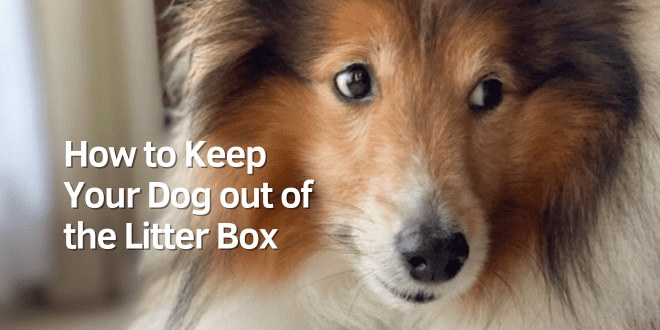
It’s certainly totally gross for us, as humans, to imagine why in the world the family dog would want to sneak into the cat’s litter box and steal a few “munchies” but it happens in homes all around the world. Many dogs just love to eat cat poop!
Understanding the Behavior
Coprophaghia, or the eating of feces, is a common behavior in many dogs. It’s seen more in puppies but some dogs never grow out of it.
There have been many theories as to why dogs engage in this behavior and the reasons can include compulsive behavior, boredom, or they may be getting some nutritive value from it. Cat food is higher in protein and fat than dog food so the waste may have taste appeal. The purpose of this article isn’t to delve into dog behavior, but rather, to help you create a litter box set-up that makes it more difficult for the dog to access the cat’s waste while still making the box a convenient place for kitty.
If your dog is engaging in the behavior, contact your veterinarian to make sure there isn’t a nutritional issue going on and also to discuss the possibility of any behavior problem being the underlying cause (boredom, compulsive behavior, etc.), especially if your dog is eating his own feces or the feces of other dogs as well. Your veterinarian may give you a taste deterrent product and/or offer some dog training advice. Depending on the severity of the problem, you may also be referred to a dog trainer or behavior expert.
How This Affects Your Cat
The litter box is basically a pretty sacred place from your cat’s perspective. If kitty approaches the box and finds shreds of feces strewn across the carpet or worse, finds the dog with his head in the box, it won’t create a comforting feeling. The litter box could also become an unsafe place as well, if the dog shoves his nose in there whenever he pleases. He may begin to follow your cat into the box in the hope of receiving a fresh snack. If you have a covered litter box set-up then the cat may feel trapped inside if the dog stands right at the entrance. Your cat may decide to find other toileting accommodations and chances are, you won’t like the places chosen.
Create a Dog-Free Litter Box Zone
In addition to figuring out the possible cause for the coprophagia and incorporating necessary training with the dog (teaching the dog the “leave it” command, and so on), it’s time to tweak the litter box set-up. If the dog can’t get to the cat’s poop, then he can’t eat it. Simple as that. The key though, is to make sure the box is convenient for the cat but inconvenient for the dog.
Gate Off the Area
The easiest way to keep the dog out of the box is to place the litter box in an area where he can’t gain access. If the dog is bigger than the cat, place a hinged baby gate in the doorway to a room that has a small cat opening in the center so the cat can easily go underneath. If you have a large dog, you can find extra tall gates that have a small pet door in the middle. The other option is to raise the gate a few inches up off the ground so the cat can get underneath but the dog can’t.
Door Latch
Another option is to install a latch that only allows the door to stay open a small amount — just enough for the cat to get through. Make sure you use a latch that locks the door in position so the dog can’t push on it and accidentally close it. The Door Buddy brand is a popular and effective latch. You can easily find it at Amazon.
Elevate the Box
If you can’t place the litter box in another room, and you’re dealing with a small dog, you may have to elevate the box. Make sure the cat doesn’t have any difficulty climbing or making a small jump.
If the litter box is elevated and you have a cat who can’t make that small jump then place a cat tree nearby so kitty can easily climb up and over to reach the box. The carpeted perches on the cat tree will make it easier for your cat to grip. If using the option of putting a cat tree near the box, make sure you also provide an additional cat tree away from the box so the cat will have a safe elevated resting area that isn’t near an elimination location. No one likes to sleep in the bathroom.
The best option though is to create a dog-free zone in another room so the cat doesn’t have the dog hanging out right by the box.
What NOT to Do
Don’t resort to using a covered litter box or stick the box in a closet with a pet door. Cats do like some privacy but most don’t like covered boxes or ones hidden in closets. These types of boxes limit escape potential. When a cat only has one way in and out of the box, it can be a set-up for an ambush by another companion animal. Many covered boxes also can make cats feel cramped in there when taking care of personal business.
Need More Information?
For more information on cat behavior and training, refer to the best-selling books by Pam Johnson-Bennett. Pam’s books are available at bookstores and online. We’ve included links to Amazon here on our website.
If you have a question about your cat’s behavior or health, contact your veterinarian. This article is not intended as a medical diagnosis nor is it a replacement for your cat’s regular veterinary care. This article is for general information purposes only.




